This is a free fortnightly newsletter about the New Zealand Net. If you would like to be notified by email when a new edition is published, please contact ZL1NZ.
Browse our Newsletter Archive and List of Net Tips.
Featured key
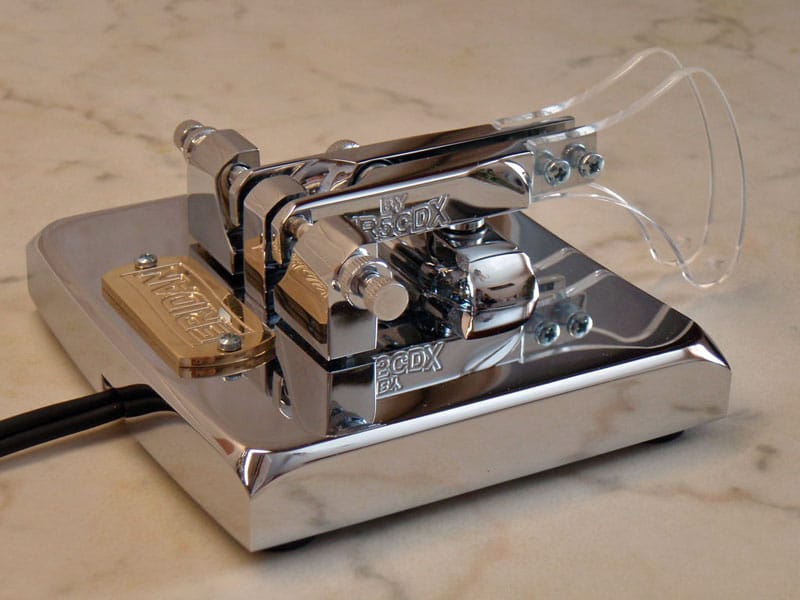
Eridan MX paddles. Photo: UR5CDX
In this edition of NZ Net News, I thought it would be appropriate to honour Ukrainian radio amateurs who are seeing their country reduced to rubble and their friends and families killed by Russian invaders. It is very hard to comprehend how this can happen and to know what can be done to end the carnage.
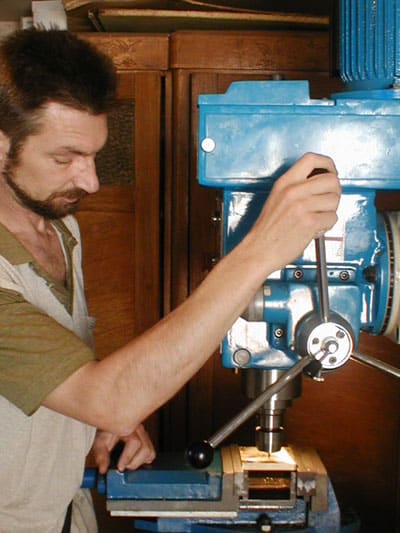 Yury Shevchenko UR5CDX is a radio amateur in Cherkasy, a city in central Ukraine.
Yury Shevchenko UR5CDX is a radio amateur in Cherkasy, a city in central Ukraine.
For the past twenty years or so, Yury hasn’t been able to do much operating, because he has been busy building lovely Morse keys, such as the top-of-the line Eridan MX dual-lever model pictured above. This key weighs a hefty 1.3kg and it sure does shine. Yury’s website shows it priced at US$293 but, unfortunately, out of stock.
His range of keys includes single and dual-lever models, although he has also built straight keys in the past.
I hope Yury and his family are OK, and that he will be able to resume making his lovely keys one day.
* If you have an interesting key for this feature, please send me a nice clear photo and a few words describing it.
Quick notes
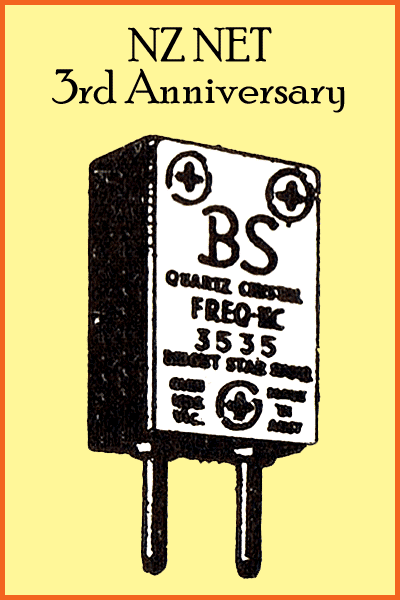 NZ Net is (almost) three years old. Our third anniversary will be on Friday 25 March, so please try to check in with Gerard ZL2VA on that date to help us celebrate another NZ Net milestone.
NZ Net is (almost) three years old. Our third anniversary will be on Friday 25 March, so please try to check in with Gerard ZL2VA on that date to help us celebrate another NZ Net milestone.
Here’s a challenge for all of us: can we get 15 check-ins on 25 March? We’ve managed 14 several times, but 15 would be cause for celebration!
ZL4KX open for traffic. During the past fortnight Bede has sent and received his first traffic on the NZ Net, so hopefully he won’t mind getting a few more radiograms. Bede has a great radio location and a big signal, so it will be really helpful having him able to QSP, particularly on the trans-Tasman circuits. Well done OM.
VK3DRQ getting stronger. Isn’t it great to hear Manny’s signal improving as the days get shorter. The past few days Manny has been QRK4 for me at the end of the net, despite very high noise. For those with low noise he must be armchair copy. 🙂
ZL4KJ heading towards NZ Net membership. Kimberly is making great progress towards 25 check-ins at which point she will be a full member of NZ Net. Although she only made her first CW contact a few days ago, her straight-key fist is easy to copy. There’s more about Kimberly later in this NZ Net News.
Photo flashback

John G4ETQ sent this photo of himself on a roundabout near Penarth, Wales several years ago. Behind him is a steel sculpture by artist Ray Smith representing the transmitter Marconi used for his first radio transmission from nearby Lavernock Point to Flat Holm island in 1897. The sculpture is based on original drawings of the circuit diagram of the equipment.
Isolation – the bad and the good
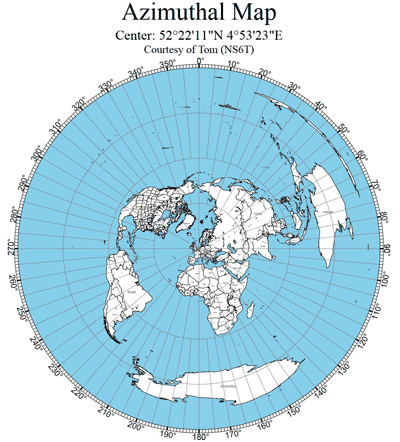
View from Amsterdam
By Gerard ZL2GVA
Ever wondered why it is a bit harder for us down under to get many contacts ‘close by’ – say within 5000 or 10,000km, than for someone in Europe?
Have a look at the maps, The first map is an azimuthal view centred on Amsterdam, and the second is centred on Wellington, New Zealand. The circles are drawn every 5000km.
On the Amsterdam map, a fair chunk of the world falls within the 10,000km circle. On the New Zealand map, however, we’re only just including Japan – and West Coast USA is a bit farther away.
I wonder what the difference in the number of licensed amateur operators within the 10,000km circles of the two maps?
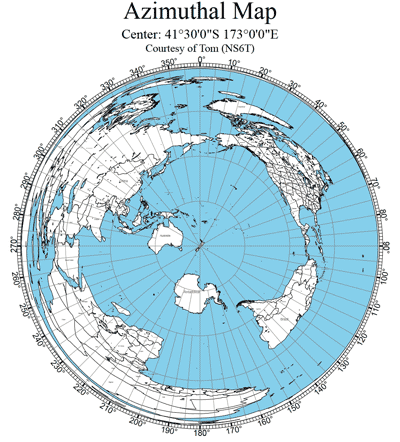
View from Wellington NZ
By Neil ZL1NZ
Gerard makes a good point, I think. We in New Zealand have to reach a lot farther for contacts, and perhaps it does take a little longer to earn DXCC or other awards.
But I think there are some advantages too. For example:
- QRM isn’t much of a problem for New Zealand hams.
- When we call CQ on 40m or higher HF bands there is often a pile-up of stations wanting to work NZ, including more than a few from Japan. 🙂
- When one of the well-equipped stations elsewhere in the world decides to beam to the South Pacific, they are easy to work because there are so few of us replying!
- Working the lovely islands of the South Pacific is easy from NZ, and when DXpeditions come to activate a tiny atoll somewhere, they often hear us on the first call, even in the pile-ups.
- Antarctic stations are practically in our backyard. How cool! (OK, bad pun).
Tips & tools: Key connection box
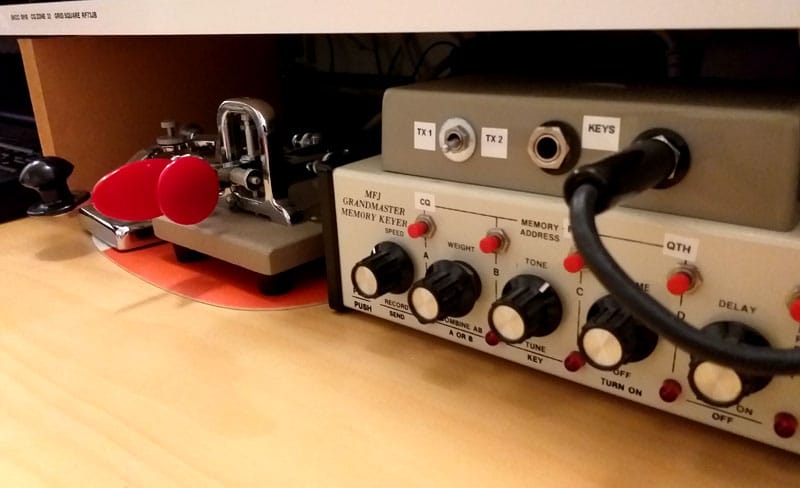
Photo: ZL1NZ
I imagine quite a few of us have a little box that looks something like the ugly grey one made entirely of junk box parts shown in this photo. This box permits me to have three keys connected in parallel and to use them with either of two transmitters.
Two keys can be plugged into the front, e.g. a straight key and a bug. The output of the electronic keyer plugs into the back of the box.
This is quite handy for switching quickly between keys. When I need to QRS I just go to the straight key, which I find to be much easier than trying to find the right speed on the keyer.
It also makes the connections more accessible. (Remember when rigs used to have their key jacks on the front panel? Nowadays they all seem to be on the back – and hard to reach.)
Got a favourite gadget or technique to make your CW operating easier or more efficient?
Please send a short article and photo to be featured in NZ Net News!
Welcome ZL4KJ
Kimberly ZL4KJ is a new CW op who has become a regular check-in to the net over the past two weeks. Her first check-in was on Tuesday 8 March, International Women’s Day – a nice touch!
Kimberly was licensed in 2017 and lives in Palmerston North, although she hopes to move to Invercargill later his year (where that ZL4 callsign will be right at home).
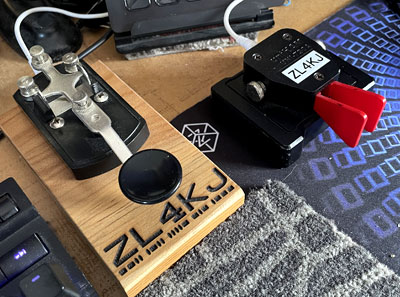 “I have always loved Morse code, since I built the Dick Smith Funway into Electronics Project 9, the Morse code communicator in the early 90s,” says Kimberly.
“I have always loved Morse code, since I built the Dick Smith Funway into Electronics Project 9, the Morse code communicator in the early 90s,” says Kimberly.
“I still use the straight key that came with that kit, although I would like to find a nicer key to have on my desk. I also have a paddle that I use with my Yaesu FT-897D’s keyer but I’d love a nice straight key for use on it, along with the FT-101E I’m restoring.
“After ditching FT8 this year I found that most of the DX SSB I could hear couldn’t hear me, but on the Reverse Beacon Network I was being reported by skimmers in Europe while running 20 watts, so I thought it was time to get good at receiving CW and improve my sending speed so I can actually have a QSO with DX stations.
“I’d also like to get to a point where I can incorporate using CW to pass traffic back and forth between Winlink HF Email.”
Its great to have Kimberly participating and to have a net station in Palmerston North, at least until she heads south.
Audio challenge
On the 1200m band there’s plenty of A2A (modulated CW) to be heard. These are the Non-Directional Beacons (NDBs) located near airports and used for aircraft navigation. They send their 2-letter identifier by keying a 1kHz tone.
Here’s a recording I made a few days ago while cruising the beacon band. All the stations are in New Zealand, and you will hear each station send its ID twice.
Your challenge is to copy as many of these IDs as you can. In one case, two stations are on the same frequency so you’ll hear them alternately. On another shared frequency one station is extremely weak, so I’ll be very impressed if you can make it out.
Send your list of IDs, plus the total number you were able to copy, via radiogram to ZL1NZ. Don’t send the station locations – just the IDs and total so we can keep the radiograms brief.
If you’re curious about where these stations are, here’s a handy list.
Answer to previous Audio Challenge:
1. The station was, of course, WNU Slidell Radio.
2. The mode for certain ships was SITOR (SImplex Teletype Over Radio).
Correct answers were received from G4ETQ, ZL1ANY and ZL3TK.
Video: School for Danger
This docu-drama, made in 1947, vividly depicts the work of British SOE agents and members of the Resistance in occupied France during WW2.
The film was recommended recently by Hiroki AH6CY, an expert on the WW2 Paraset spy radio, who commented:
“It is a rather accurate recreation of SOE training and activities, acted out, among others, by two of the actual SOE agents who served in France (Harry Rée and Jacqueline Nearne). The aircraft, buildings, weapons, etc. used in the film were real ones.
“An interesting thing is that the name SOE was never mentioned, true to the secret nature of the SOE organisation.”
Indeed, several people play themselves in the film, made just two years after the war ended.
In addition to the many scenes in which Jacqueline Nearne sends Morse, the entire film is enthralling.
Isn’t it interesting that the RAF would have produced this film so soon after the war, considering that much of the clandestine war effort remained secret until just a few years ago.
Net tip: Op Note
When sending a radiogram, it can be helpful occasionally to include additional information for the receiving or relaying operator.
This information is inserted into the radiogram using an Op Note, which can be placed at the end of the Address, Body or Signature sections of the radiogram (not in the Preamble).
An Op Note placed in the Address section might look like this:
= JOHN SMITH TEL 5551234 OP NOTE PLEASE RING BETWEEN 2 AND 6 PM ONLY =
Notice that there are no special characters to define the start and end of the Op Note, it just becomes part of its section, in this case the Address.
The words “OP NOTE” and any text that follows are NOT included in the radiogram check numbers.
The Op Note should be as brief as possible.
There is currently a radiogram circulating on the NZ Net (a “Chinese whispers” type of exercise) containing an Op Note in the Signature, which serves to track the progress of this message as it is relayed from station to station. Each station that handles the message is instructed to update the Op Note before sending the radiogram onward. So, an Op Note can be added, edited or deleted if appropriate even after a radiogram has started its journey.
Op Notes should be used sparingly, and should not be used for instructions that could be covered by a three-letter HX code in the Preamble.
Advertising archive

QST, June 1976
Suggestions?
If you have suggestions on how to make the NZ Net better, or things you’d like to see covered in these updates, please contact ZL1NZ. You might even like to write something for the newsletter.
Thanks for reading, and I hope to hear you soon on the NZ Net!
—
Neil Sanderson ZL1NZ, Net Manager
New Zealand Net (NZ NET)
3535.0 kHz at 9pm NZT Mon-Fri



